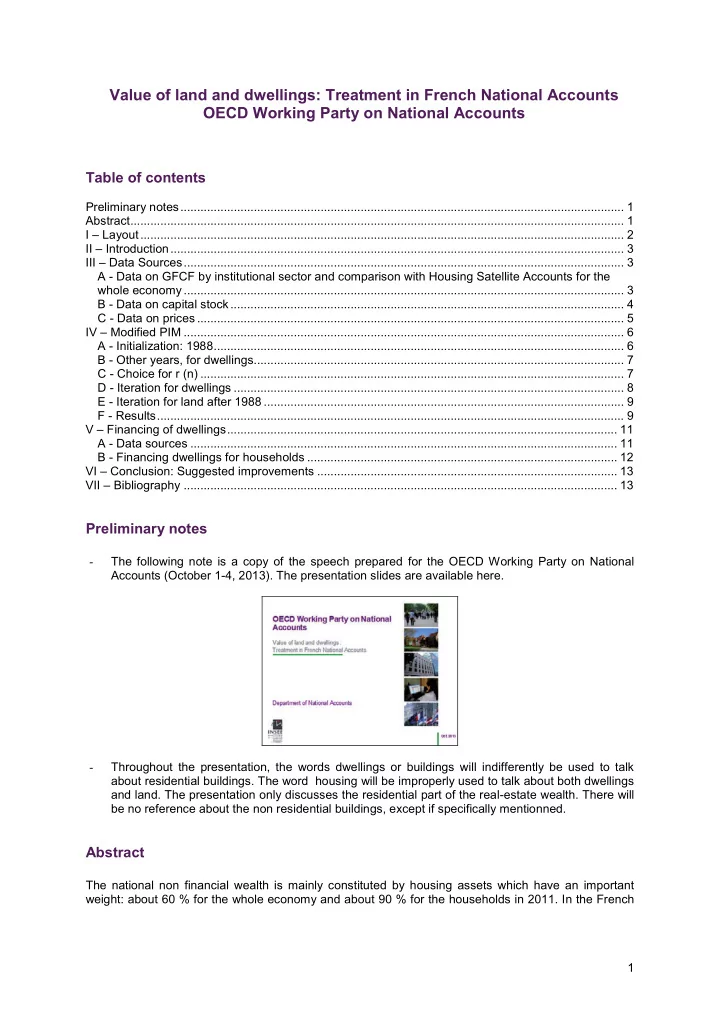

Value of land and dwellings: Treatment in French National Accounts OECD Working Party on National Accounts Table of contents Preliminary notes ..................................................................................................................................... 1 Abstract .................................................................................................................................................... 1 I – Layout ................................................................................................................................................. 2 II – Introduction ........................................................................................................................................ 3 III – Data Sources .................................................................................................................................... 3 A - Data on GFCF by institutional sector and comparison with Housing Satellite Accounts for the whole economy .................................................................................................................................... 3 B - Data on capital stock ...................................................................................................................... 4 C - Data on prices ................................................................................................................................ 5 IV – Modified PIM .................................................................................................................................... 6 A - Initialization: 1988 ........................................................................................................................... 6 B - Other years, for dwellings............................................................................................................... 7 C - Choice for r (n) ............................................................................................................................... 7 D - Iteration for dwellings ..................................................................................................................... 8 E - Iteration for land after 1988 ............................................................................................................ 9 F - Results ............................................................................................................................................ 9 V – Financing of dwellings ..................................................................................................................... 11 A - Data sources ................................................................................................................................ 11 B - Financing dwellings for households ............................................................................................. 12 VI – Conclusion: Suggested improvements .......................................................................................... 13 VII – Bibliography .................................................................................................................................. 13 Preliminary notes - The following note is a copy of the speech prepared for the OECD Working Party on National Accounts (October 1-4, 2013). The presentation slides are available here. - Throughout the presentation, the words dwellings or buildings will indifferently be used to talk about residential buildings. The word housing will be improperly used to talk about both dwellings and land. The presentation only discusses the residential part of the real-estate wealth. There will be no reference about the non residential buildings, except if specifically mentionned. Abstract The national non financial wealth is mainly constituted by housing assets which have an important weight: about 60 % for the whole economy and about 90 % for the households in 2011. In the French 1
balance sheet, the treatment of housing wealth distinguishes the valuation of buildings from the valuation of lands underneath buildings, as suggested by the European System of Accounts (ESA). The net value of residential buildings is calculated using a perpetual inventory model. Like the other fixed assets, this method allows to evaluate the stocks by accumulating flows of investment in dwellings (GFCF of new dwellings and substantial repair and maintenance) with an estimated rate of depreciation. Data on housing stocks (dwellings + land) are also available in France. The perpetual inventory model is improved in order to integrate this additional information: the total value of the housing stock is provided every five years by a specific survey known as “National Housing Survey”. The valuation of housing wealth is based on two different price indexes: the buildings price follows the construction cost index and the total of housing stocks (buildings + land) is valued according to the housing price index. Eventually, with this method, the land price supports the main part of the housing prices’ evolution, especially recently. This reflects the fact that localization is the most important factor which determines the price of housings. The presentation will focus on the description of the methodology used in French national accounts to evaluate non financial housing wealth. A few points on expected improvements for the base-year 2010 will also be developed. I – Layout [Slides 1 & 2] The purpose of this presentation is to explain the method used in French national accounts to measure the value of possessed dwellings and of land attached to these dwellings. It is meant to be a technical presentation which sets forth the data sources and the methods associated with the building of this account. The latter have not significantly changed since the base-year 1995. At the end of the presentation, several elements about the changes planned for the base-year 2010, to be published in late 2014, will also be given. The layout of this presentation is as follows: First, a brief introduction to recall the history of the building of the French balance sheet. Second, the details of the French data sources on housing: for Gross Fixed Capital Formation (GFCF), price indexes and stocks of dwellings and land series. Third, what is commonly refered to as the perpetual inventory method. And more specifically when used for that particular kind of asset which is housing, meaning dwellings plus land. This method enables us to build the series of dwelling capital stocks. And it also enables us to find the price index which is then used to value the land on which dwellings are built, the land underneath dwellings. Fourth, some results on the financing of housing for French households. Some of the time series presented in this section are included in the French national accounts but are not produced by Insee (French national institute of statistics and economic studies). The French central bank and the ministerial statistical service for sustainable development (which provides the satellite account for housing) publish more detailed information on the different types of financing used by households. Throughout the presentation, the consistency between the different data sources on housing will be studied. To conclude, a short presentation of the improvements that are implemented for the transition to the base-year 2010 of national accounts. 2
Recommend
More recommend